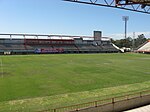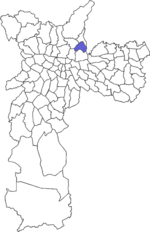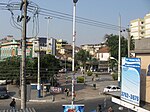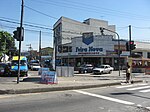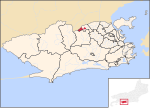Baixada Fluminense

The Baixada Fluminense (standard Portuguese pronunciation: [ˌbajˈʃadɐ flumiˈnẽjsi]; local pronounce: [ˌbɐ(j)ˈʃadɐ flumɪˈnẽ(j)si]) (literally "Fluminense Lowland") is a region in the state of Rio de Janeiro, in southeastern Brazil. It is located on Guanabara Bay, between Rio de Janeiro to the south and the Serra dos Órgãos range of hills to the north. Its municipalities are part of the Rio de Janeiro Metropolitan Region. The Baixada Fluminense region's population is about three million, making it the second most populous region in the state, following only the city of Rio de Janeiro. This region should not be confused with the Baixadas Litorâneas, located farther to the east in the same state.
Excerpt from the Wikipedia article Baixada Fluminense (License: CC BY-SA 3.0, Authors, Images).Baixada Fluminense
Via Light, Nova Iguaçu Centro
Geographical coordinates (GPS) Address Nearby Places Show on map
Geographical coordinates (GPS)
| Latitude | Longitude |
|---|---|
| N -22.759722222222 ° | E -43.442777777778 ° |
Address
Via Light
26220-040 Nova Iguaçu, Centro
Rio de Janeiro, Brazil
Open on Google Maps


